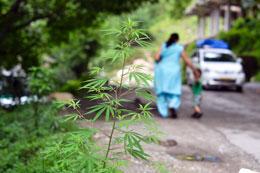Pot players eye Asia as new cannabis frontier

By Fabian Dawson
Mata Press Service
Asia is poised to be a new frontier for major pot players and its marijuana market is projected to grow to as much as US$5.8 billion by 2024, says a new report by a cannabis industry data and intelligence company.
The report by London-based Prohibition Partners estimated that Asia’s cannabis usage is about two percent, or 85.5 million people and that several Asian countries are on the cusp of embracing medical cannabis.
“Cannabis use is deeply rooted in some of the region’s ancient medical practices, and we expect to see medicinal cannabis gain favour ahead of any acceptance of recreational,” said the report authors.
“In our view, while Asian investors and start-ups continue to keep an eye on legal developments in Europe and North America, Western-based cannabis companies are getting ready to explore new opportunities in the Asian market.”
“With a sizeable population and rising standards in education come valuable market opportunities, and the international cannabis industry is keeping a close eye on legislative developments throughout the region.”
These major developments include:
• In Thailand, the legalization of medical cannabis was officialized by royal decree in The Royal Gazette on 18 February 2019. Recreational cannabis, however, remains illegal.
• In Malaysia, in February 2019, the health ministry stated that it would consider allowing the use of medical cannabis. Deputy Health Minister Dr. Lee Boon Chye said: ‘If there is enough information to show it [medical cannabis] is safe and effective for use for certain conditions, then the ministry will be able to consider based on the particular indication.’
• Under the zero-tolerance policies of President Rodrigo Duterte, recreational cannabis remains illegal in the Philippines, whilst medicinal cannabis is governed by the Compassionate Medical Cannabis Act. This means that it can be accessed only through a licensed Medical Cannabis Compassionate Centre within a hospital. Patients require authorization from a doctor to be eligible to receive treatment for conditions such as arthritis, epilepsy, cancer, HIV and multiple
sclerosis (MS).
• In Laos, it is unlikely that medical cannabis will be legalized in the near future. In November 2018, the government published the new Penal Code, which increased penalties and stipulated additional acts that constitute offenses. Laos continues to enforce the death penalty for certain crimes, in stark
Here is a snapshot of what’s happening when it comes to Cannabis legislation in some of the Asian nations:
INDIA
Cannabis is India’s most popular drug, and both sativa and India are native to the country, growing wild in gardens and parks in the monsoon season. The potential legalization of medical cannabis was widely reported in the media in November 2018, with scientists said to be actively studying its therapeutic properties for the management of conditions associated with cancer, epilepsy and sickle-cell anemia. Two states, Himachal Pradesh, and Jammu and Kashmir have sought to legalize cannabis cultivation.
CHINA
Current legislation in China makes no distinction between medical and recreational cannabis, and the cultivation, possession and/or use of cannabis with a THC content >0.3%, for medical or other purposes, are prohibited. There is currently no indication that this is likely to change, despite positive developments elsewhere in the region. However, as Chinese companies begin to explore business opportunities in the medical cannabis sector for investment purposes, there may be increased support for a review of the current legislation.
HONG KONG
The Special Administrative Regions of China are likely to keep step with developments in neighbouring China. However, we predict that given its high level of Western exposure, Hong Kong is likely to act as a testing ground for the legalization and regulation of cannabis.
SOUTH KOREA
South Korea has adopted a law legalizing medical cannabis, which took effect on 12 March 2019. Under the revised law, cannabis derivatives that have been approved abroad for self-treatment purposes can be brought into South Korea through the Korea Orphan and Essential Drug Centre (KOEDC). Patients must apply for the medication through an online process.
TAIWAN
In Taiwan, cannabis is a schedule 2 narcotic, and possession can result in up to three years’ imprisonment. Taiwan is expected to remain one the region’s least progressive nations when it comes to cannabis use.
SRI LANKA
Cannabis is used extensively in Ayurvedic medicine and may be sold legally in Ayurveda outlets. Health Minister Rajitha Senaratne announced in 2017 that the country would begin cultivating cannabis for medical purposes. In March 2018, a plantation in the Anuradhapura and Polonnaruwa districts was launched with an expected yield of 25 tonnes annually. Sri Lanka plans to appoint farmers to cultivate cannabis, and the military would oversee production. According to the government, there would be no need for permits since the private sector would not be party to cannabis cultivation.
THE PHILIPPINES
Despite being one of the most widely used drugs in the Philippines, cannabis is a Schedule 1 drug, which limits its use to medicinal and scientific use. As a controlled substance, the recreational use of cannabis remains illegal in the Philippines. Cultivation, possession, and consumption are illegal. Medical Cannabis can only be obtained at a Compassionate Centre only, which must be licensed and located within a hospital. Having already passed in the lower house, more liberal medical cannabis use is expected to pass the Senate within the next couple of months.
SINGAPORE/MALAYSIA
Although Singapore maintains strict penalties for drug offenses, there are signs of change.
Alongside Malaysia, Singapore is in the early stages of debating whether or not to legalize medical cannabis.






